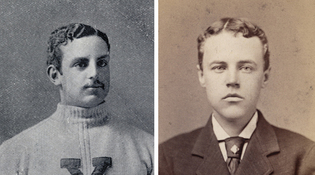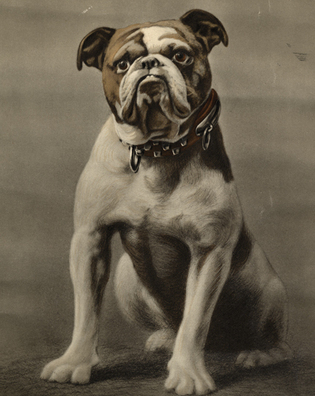 loading
loading
Old YaleA tale of two bulldogsHandsome Dan wasn’t Yale’s first bulldog mascot. But he earned his place as its most famous. Judith Ann Schiff is chief research archivist at the Yale University Library.  Manuscripts and ArchivesAndy Graves (left), Class of 1892 in Yale's Sheffield Scientific School and a prominent athlete on campus, was the owner of Handsome Dan (below). But it turns out that Dan was Yale's second bulldog. Edgar Sheffield Porter (right, in an 1876 photograph), Sheffield Class of 1880 and ’82MED, may have been responsible for bringing the first bulldog mascot to Yale. View full imageThe first Yale bulldog, as every Yale history enthusiast knows, was Handsome Dan, bought by Yale student Andrew Barbey Graves in 1889 from a New Haven blacksmith. Dan became the athletics mascot, and because of him, to this day Yale sports competitions and other events are attended by a real bulldog on a leash—Handsome Dan XVII. Until recently, I too thought Handsome Dan was Yale’s first bulldog. But it turns out that he had a predecessor. While doing research for a piece on Dan’s 125th birthday, I found that he was actually the second bulldog to represent the school. One piece of evidence was in the Yale Daily News. The issue of November 22, 1890, announced: “Harper the Champion English bulldog will be taken to Springfield today as a mascot to the Yale team.” It was not until 1892 that there is any record of Dan as mascot. The June 23, 1892, issue of Forest and Stream noted that Dan would be “the Yale mascot this year in the place of the champion Harper.” Harper was an imported English bulldog, son of a champion dog named British Monarch. His owner was R. B. Sawyer, who cofounded the Bulldog Club in 1890. (The breed was officially recognized by the American Kennel Club in 1886.) We know little about Sawyer other than that he owned a kennel in Derby, Connecticut, that raised pugs and bulldogs. But there are at least two Yale connections. When Sawyer was out of the country during the first Bulldog Club dog show, in February 1891, he had another bulldog enthusiast serve as Harper’s handler. The Dog Book (1906) records that in the competition, Sawyer’s “grand dog, Harper, was now shown by Mr. F. W. Sacket and won the Parke Challenge Cup.” Sacket, Class of 1891, lived at 219 Durfee Hall. Sawyer’s other known Yale connection was the man with whom he cofounded the Bulldog Club: Edgar Sheffield Porter of New Haven, one of the better-known authorities on dogs in America. Porter had exceptionally close links to Yale. Not only had he attended Yale’s Sheffield Scientific School, Class of 1880, and the Yale medical school—though he didn’t graduate from either—but also, he was the grandson of Sheffield’s founder, the son of a Yale professor, and the nephew of Yale president Noah Porter. Given Porter’s ties to Yale, and the fact that Porter and Sawyer were colleagues on the Bulldog Club, it may have been Edgar Sheffield Porter who was responsible for bringing bulldogs to Yale.  Manuscripts and ArchivesThe original Handsome Dan (1887–97) was beloved by Yale students. It was said that he would never associate with anyone else. View full imageBut Handsome Dan still deserves his place of honor in Yale athletics history, due to his sheer popularity. Dan took over the mascot role very soon after Harper had started it, and he quickly became a campus character. The same 1892 Forest and Stream that mentioned his debut called him “the well-known bulldog Handsome Dan.” It continued, “‘Andy’ Graves rows No. 7 in the Yale boat and though Dan will hardly have a place in the crew he will occupy a prominent position on the bank decked out in the Yale blue.” The Philadelphia Press, as quoted by the Yale athletics website, described Dan’s fame: A favorite trick was to tell him to ‘Speak to Harvard.’ He would bark ferociously and work himself into physical contortions of rage never before dreamed of by a dog. Dan was peculiar to himself in one thing—he would never associate with anyone but students. Dan implanted himself more firmly in the hearts of Yale students than any mascot had ever done before. Handsome Dan may have become known at Yale partly because his owner was a prominent athlete. Graves rowed on the freshman crew, was a sub on the varsity crew, and rowed on the 1892 crew. He was also a tackle on the football team. Contrary to some Yale accounts that call Graves an English gentleman, he was actually the son of a very wealthy wallpaper manufacturer, born at the family summer estate in Tarrytown, New York, and raised in Brooklyn. (In 1894 the New York Times would report on his secret marriage to the “Poor, but Refined and Amiable” Miss Herne, “a Cambridge, Mass. Beauty.”) Did Graves really buy his puppy from a blacksmith? Probably not. The American Kennel Club Stud Book of 1890 records that Handsome Dan’s parents—Peggy and Caliban—were pedigreed dogs and that his breeder was a William North of New Haven. Dan would win some 30 awards at dog shows over his lifetime. (He may have been named after Handsome Dan Murphy, a Boston gambler and boxer of the time.) But Dan was also Yale’s mascot for almost all his life. When Graves was traveling, his brother, William Leon Graves ’97 Sheffield, took care of the dog. In 1896, Andy Graves brought Dan to live with him in England, where he had moved temporarily, and Dan died there in 1897. After Dan’s death, newspaper reports on Yale games started referring to Yale teams that had been spurred on by “the spirit of the bulldog.” In 1906, a Yale team was finally called “the bulldogs” in print: a New York Tribune report on the Princeton football game declared, “The Yale bulldogs came on the field with a defiant growl.” The Yale Daily News first used “the bulldogs” in 1909, in an article about the freshman basketball team. It was also in 1909 or 1910 that Cole Porter wrote the iconic fight song: “Bull-dog! Bull-dog! Bow, wow, wow.” All this can be attributed to Handsome Dan. When Dan died, Charles Hopkins Clark ’71, editor of the Hartford Courant, wrote an editorial that testifies to the dog’s unforgettable personality: In personal appearance he seemed like a cross between an alligator and a horned frog, and he was called handsome by the metaphysicians under the law of compensation. The title came to him; he never sought it. He was always taken to games in a leash, and the Harvard football team for years owed its continued existence to the fact that the rope held.… If he has gone to that heaven which some humane people think exists for animals, we venture the prediction that there is music just now in the bulldog corner.
The comment period has expired.
|
|